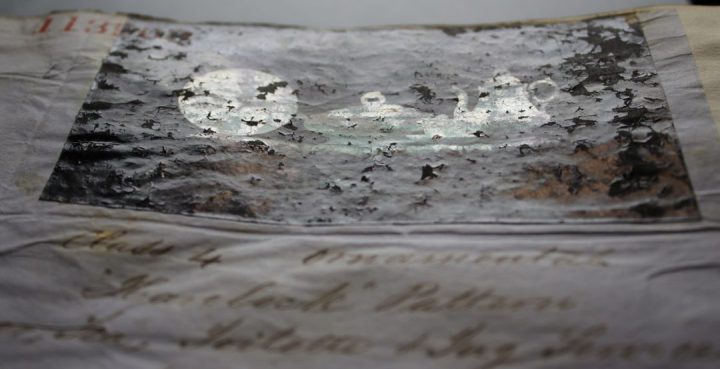
Analysis, characterisation and conservation of early, rare photographic processes
The Designs Registers, part of the Board of Trade (BT) series, contain almost three million British patterns, designs and trademarks from 1839 until 1991. They are one of the most visually captivating collections at The National Archives. Among drawings, sketches and material samples of designs, 10 unusual photographic images were discovered in BT43/67. Unlike other photographs in the volume, seven out of these 10 had stuck to the opposite page.

Ioannis examining a pannotype in a Design Register under the microscope
Working together, photograph conservator Ioannis Vesallos and senior conservation scientist Lucia Pereira-Pardo identified the photographic process and designed an innovative conservation treatment for this rare set of photographs.

An example of a pannotype that has deteriorated
The supporting material for the photograph image was a black textile and not paper or tin, which were common for the period. Initially, analysis was carried out using X-Ray fluorescence spectroscopy (XRF) to understand the elemental composition of the image layer. Silver, which was the primary element for making photographs in the 19th century, was detected on all the photographs analysed.
Testing different areas on the same photographs, we identified higher amounts of silver in the highlight areas compared to the darker areas. This is an indication that the image is actually reversed, and placed against the black background of the textile it appears as positive.
The image layer would have been stripped from a glass support and placed on the cloth. This allowed the conclusive identification of the photograph as a pannotype, a rare photographic process popular for a short period between 1850s and 1870s.
The results revealed that the top surface of nine of the photographs is made of a natural resin, and one which was identified as collodion. It is very likely that pannotypes were coated with a varnish, like a natural resin, to protect the silver contained in the collodion image layer. According to 19th century literature, shellac or amber were often used. The results obtained from the Fourier transform infrared spectroscopy (FTIR) were compared with those of amber and shellac and found to be very similar.
The study suggests that the varnish treatment caused the opposite page to adhere to the pannotypes. Our in-house analysis helped with the identification of the photographic process, providing more information about the way the items were created, and opened a way toward developing an innovative treatment method. However, Ioannis and Lucia did not stop there. In collaboration with the ISAAC lab researchers at Nottingham Trent University, optical coherence tomography (OCT) and external reflection Fourier transform infrared spectroscopy (ER-FTIR) was carried out. These non-destructive techniques revealed even more about the photographs, and aided Ioannis in his treatment.
To learn more, read the two-part blog series about this work here and here.
- ArcHives: ‘omics in the archive
- ‘EnSight’: Knowledge Transfer Partnership
- Computer vision: AI for analysis and searching across watermarks and merchant marks
- Conservation of Samuel Holland’s 1765 map of Prince Edward Island
- The impact of dust on our collections
- Conserving transparent papers
- Collaborative working practices: Mind the Gap